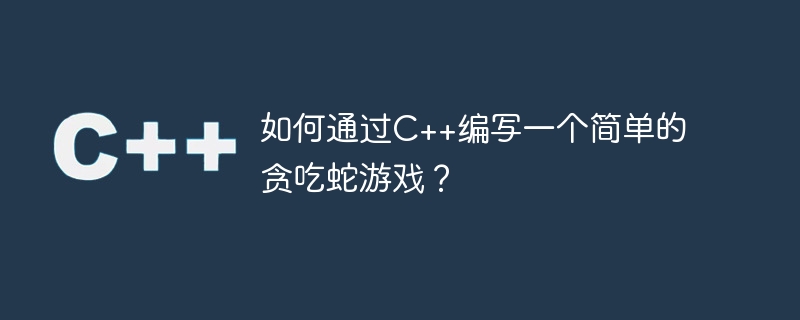
How to write a simple snake game in C?
Snake game is one of the classic games. Eat food and get points by controlling the movement of the snake. This article will introduce the steps and ideas for writing a simple snake game using C.
Steps:
- Introduce the necessary header files and libraries: First, we need to introduce the iostream header file for input and output operations, as well as header files such as conio.h and windows.h To implement the functionality of the console window.
- Define constants and global variables: At the beginning of the program, we need to define some constants to define the characters of the snake body, the initial length of the snake, and the size of the map, etc. At the same time, some global variables need to be defined, such as the coordinates of the snake, the coordinates of the food, the current score, etc.
- Initialize the map and snake: Before entering the game, we need to create a two-dimensional array to represent the game map. By looping through the entire array, the positions of the wall, snake's body, and food are initialized to the corresponding characters. At the same time, initialize the snake's coordinates and set the initial position and initial direction.
- Game main loop: In the game main loop, we continuously read the player's input and change the direction of the snake based on the input. Next, we update the snake's position and check whether it collides with food or hits a wall, etc., to decide whether we need to continue the game or the game is over.
- Update the snake's position: According to the snake's current direction, we can move the snake by incrementing or decrementing the snake's coordinates. At the same time, we also need to update the position of the snake's body, store the current position in an array, and refresh the state of the entire map in each game loop.
- Detect collision: In each game loop, we need to detect whether the snake head collides with the food. If there is a collision, the score needs to be increased and the food's location regenerated. At the same time, we also need to detect whether the snake head collides with the snake body or with the wall. If a collision occurs, the game will be over.
- Output the current game state: In each game loop, we need to clear the console window and output the current map state. At the same time, we also need to output information such as the current score and game description.
- Game end: When the game ends, we need to output the game end information, including the final score and whether to continue the game, etc. At the same time, we also need to decide whether to restart the game or exit the game based on whether the player continues the game.
Idea:
The key to writing a snake game is to clarify the logic and control flow of the game. First, we need to determine the size and initial state of the game map, including the location of walls, snakes, and food. Then, in each game loop, we need to receive input from the player and change the direction of the snake based on that input. At the same time, we also need to update the snake's position and check whether it collides with food or hits a wall, etc. Finally, we need to determine whether the game continues based on the conditions at which the game ends.
Through the above steps and ideas, we can use C to write a simple snake game. With the mastery of C language and in-depth understanding of game logic, we can also expand the game and add more functions and features to make the game richer and more interesting. Writing a snake game can not only improve our programming skills, but also cultivate our logical thinking and problem-solving skills. I hope this article was helpful in writing your Snake game.
The above is the detailed content of How to write a simple snake game in C++?. For more information, please follow other related articles on the PHP Chinese website!


 What are the differences between c++ and c language
What are the differences between c++ and c language Recommended learning order for c++ and python
Recommended learning order for c++ and python Cost-effectiveness analysis of learning python and c++
Cost-effectiveness analysis of learning python and c++ Is c language the same as c++?
Is c language the same as c++? Which is better to learn first, c language or c++?
Which is better to learn first, c language or c++? The difference and connection between c language and c++
The difference and connection between c language and c++ C++ software Chinese change tutorial
C++ software Chinese change tutorial Cost-effectiveness analysis of learning python, java and c++
Cost-effectiveness analysis of learning python, java and c++



